Iceland Wildlife & Nature Tour Report 2022
16 November 2022


























































































The last rays of sun crushed between the sea and the leaden sky at Flatey (image by Mike Watson)

Travel days are a post-pandemic problem everywhere nowadays and, short of a pianist, there wasn’t much to do in Flatey’s ferry terminal (image by Mike Watson)

More no-expense-spared tourist facilities at Svötuloft (image by Mike Watson)

Common Loon (or Great Northern Diver) is essentially a North American breeding bird but has an outpost in Iceland. Can you spot 2 days old junior riding on her back? (image by Mike Watson)

Rock Ptarmigans occur at sea level in Iceland! (image by Mike Watson)

Snow Buntings were singing from almost every building on Flatey this year, maybe owing to a cold spring? (image by Mike Watson)

Rock Ptarmigan is starting to make a comeback after dropping to a very low level in Iceland in recent years (image by Mike Watson)

This female did not have any ducklings in tow, her drake still with her on Flatey Island (image by Mike Watson)

Ian gazes out to sea from Ferry Baldur on the way to Flatey Island (image by Mike Watson)

Harlequin is probably Iceland’s most iconic bird, there are few better locations to see them in the world than the rushing mountain rivers of northeast Iceland (image by Mike Watson)

(Almost) midnight sunset at one of Iceland’s iconic landscape locations, Kirkjufell (image by Mike Watson)

Gullfoss is thought to be Iceland’s most beautiful waterfall by many people, it has a couple of steps, a nice canyon and very often an afternoon rainbow (image by Mike Watson)

We visited Godafoss on a sunny day this time (image by Mike Watson)

Room with a view, Flatey Hotel (image by Mike Watson)

Frédéric and Wilo waiting on a bird on Flatey’s east coast (image by Mike Watson)

Wilo escapes from another tourist fleecing shop with some funds still intact (image by Mike Watson)

Rock Ptarmigan, male, still with much white winter plumage in June (image by Mike Watson)

Red-necked Phalarope – the female of the species is brighter than the male (image by Mike Watson)

Rock Ptarmigans make noisy display flights (image by Mike Watson)

By June drake Barrow’s Goldeneyes have mostly deserted their partners and form bachelor groups downstream from the breeding areas (image by Mike Watson)

Red-necked Phalarope in the kelp on Flatey (image by Mike Watson)

More happy Wild Images whale watchers at Husavík (image by Mike Watson)

Some of our happy Wild Images whale watchers at Husavík (image by Mike Watson)

A puffin catcher depicted in the wonderful mural on the ceiling of Flatey church (image by Mike Watson)

Dettifoss, with WB warmed up to show the dirty glacial meltwater that thunders over its falls (image by Mike Watson)

Volcanic landscape photography taking place at Lake Myvatn (image by Mike Watson)

European Golden Plover, a jewel of the Icelandic tundra (image by Mike Watson)

Geothermal energy plant at Lake Myvatn – Icelanders don’t rely as much on gas and electricity for power as some! (image by Mike Watson)

Þingvellir – ‘Wilo, have you really bought a bird book?’ (image by Mike Watson)

Humpback Whales look great against the snowy mountain backdrop of Skjalfandfi Bay, Husavík (image by Mike Watson)

Black-tailed Godwit is a very fine and happily common breeding bird in Iceland (image by Mike Watson)

Ian and Wilo pausing between photo sessions at Flatey Hotel (image by Mike Watson)

The delightful Icelandic form of Common Redpoll can be seen easily near Lake Myvatn (image by Mike Watson)

Peering under the water’s surface in search of a tasty meal (image by Mike Watson)

Black Guillemots are a common sight along Iceland’s rocky west coast (image by Mike Watson)

Strokkur is a very reliable geyser, blowing every few minutes but watch out for a double-blow! (image by Mike Watson)

Mother eider and her ducklings on Flatey Island (image by Mike Watson)

Þingvellir – site of the Iceland’s first parliament, on the mid-Atlantic ridge (image by Mike Watson)

A Black-legged Kittiwake floats by us on Flatey Island, where they breed (image by Mike Watson)

V is for Victory (image by Mike Watson)

Macro magic happening at Þingvellir (image by Mike Watson)

A drake Barrow’s Goldeneye battles its way through the rapids and clouds of chironomid flies near Lake Myvatn (image by Mike Watson)

It’s behind you Ian! Well, all around you actually! Flatey is full of birds (image by Mike Watson)

Humpback Whales are usually seen on every one of our whale watching trips out of Husavík, an astonishing strike rate (image by Mike Watson)

Common Ringed Plover in the kelp on Flatey Island (image by Mike Watson)

No-one minded the rain! Johanne and Michel at Dettifoss (image by Mike Watson)

The main step at Gullfoss in Iceland’s ‘Golden Triangle’ (image by Mike Watson)

Whale watching at Husavík is done from small, converted fishing boats and the whales are often very friendly! (image by Mike Watson)

Horned (or Slavonian) Grebe is a scattered breeding bird of the northeast (image by Mike Watson)

The white wings of a Humpback Whale turn the water green when they near the surface (image by Mike Watson)

Horned Grebe looking horny! (image by Mike Watson)

A nesting ledge on the basalt cliffs of Svötuloft with both Common and Thick-billed Murres (image by Mike Watson)

Þingvellir is one of Iceland’s ‘Golden Triangle’ tourist attractions (image by Mike Watson)

Idyllic Flatey is a perfect place to hideaway! If I disappear start looking there (image by Mike Watson)

Chantal is escorted from the vicinity of an Arctic Tern colony on Flatey by one of the angry birds (image by Mike Watson)

Red-throated Loon seen through a haze of Nootka Lupins (image by Mike Watson)

Female Harlequin, partly obscured! (image by Mike Watson)

Namafjall in northeast Iceland (image by Mike Watson)

With WIFI in so many remote regions now, you can even run your restaurant in da Caribbean from Flatey! (image by Mike Watson)

A Greenland-tundra-bound(?) Ruddy Turnstone on Flatey Island (image by Mike Watson)

Angry Birds! Arctic Terns breed all over Iceland (image by Mike Watson)

We tiptoed around the smelly mud in the rain at Namafjall this time (image by Mike Watson)

Red-necked Phalaropes can be found everywhere on Flatey Island (image by Mike Watson)

Öxarárfoss at Þingvellir, a wider view (image by Mike Watson)

Eurasian Whimbrel is one of the commonest breeding shorebirds in Iceland (image by Mike Watson)

Pretty Mountains Avens carpets the older lava fields at Snaefellsnes National Park (image by Mike Watson)

Well it is not called ‘Lake of the Flies’ for no reason, Frédéric near Myvatn (image by Mike Watson)

Northern Fulmars are common breeding birds in western Iceland (image by Mike Watson)

Godafoss is a perfectly formed horseshoe falls in northeast Iceland (image by Mike Watson)

After generations of hunting them for food, Atlantic Puffins appear to be returning to Flatey (image by Mike Watson)

Chantal using modern facilities to find an angle at an ancient location, Þingvellir (image by Mike Watson)

Female Harlequin, a subtle beauty of the rushing mountain rivers (image by Mike Watson)

Humpback Whales spend the northern hemisphere winter in da Caribbean, but they venture north to the food-laden waters of northern Iceland in the summer (image by Mike Watson)

The beady blood-red eye of a Common Loon (image by Mike Watson)

A Harlequin shoots the rapids in northeast Iceland (image by Mike Watson)

This male Common Loon was on its way out to sea to feed from its breeding lake in northeast Iceland. Look how his bill is slightly differently shaped to the female earlier (image by Mike Watson)

Öxarárfoss at Þingvellir, another perfectly formed little falls (image by Mike Watson)

Red Phalarope – the grand prize on Flatey. It is declining fast as a breeder in Iceland so get it while you still can (image by Mike Watson)

This Black-tailed Godwit must have chicks nearby – so we did not linger long! (image by Mike Watson)

Both Red-necked (left) and Red Phalaropes forgaing in the floating kelp at high tide on Flatey Island (image by Mike Watson)

Basalt seabird cliffs at Svötuloft on the Snaefellsnes Peninsula (image by Mike Watson)

Stokkur at Geysir blowing in the sunshine (image by Mike Watson)

Red-necked Phalarope on Flatey, every ditch and even the tiniest mires seemed to have one this time (image by Mike Watson)

The bright orange Svötuloft Lighthouse (image by Mike Watson)

Mighty Dettifoss in cold blue light (image by Mike Watson)

Lumpfish drying racks on Flatey, their roe in the hotel restaurant was delicious (image by Mike Watson)

Seabird photography on Flatey Island is great fun! (image by Mike Watson)

There is plenty to do in the midnight sun in Iceland, you may need to take a nap – Wilo on Ferry Baldur (image by Mike Watson)
I can’t say how good it felt to step outside the airport terminal at Keflavik this time and feel the cold clean air. It was happening at last! It has been a difficult couple of years for everyone, particularly for us in the travel industry, and our frustrated photographers stuck at home. Although I have visited Iceland in recent years with Birdquest, this year’s twice deferred tour was only Wild Images’s second to the ‘Land of Ice and Fire’, the previous one being 5 years ago, so I had been looking forward to returning. Our eleven days road trip took us from the southwest of the island to the edge of the Arctic Circle in the northeast and focussed on wildlife photography, mostly birds but also a few whales and there were also some great landscapes to point our cameras at.
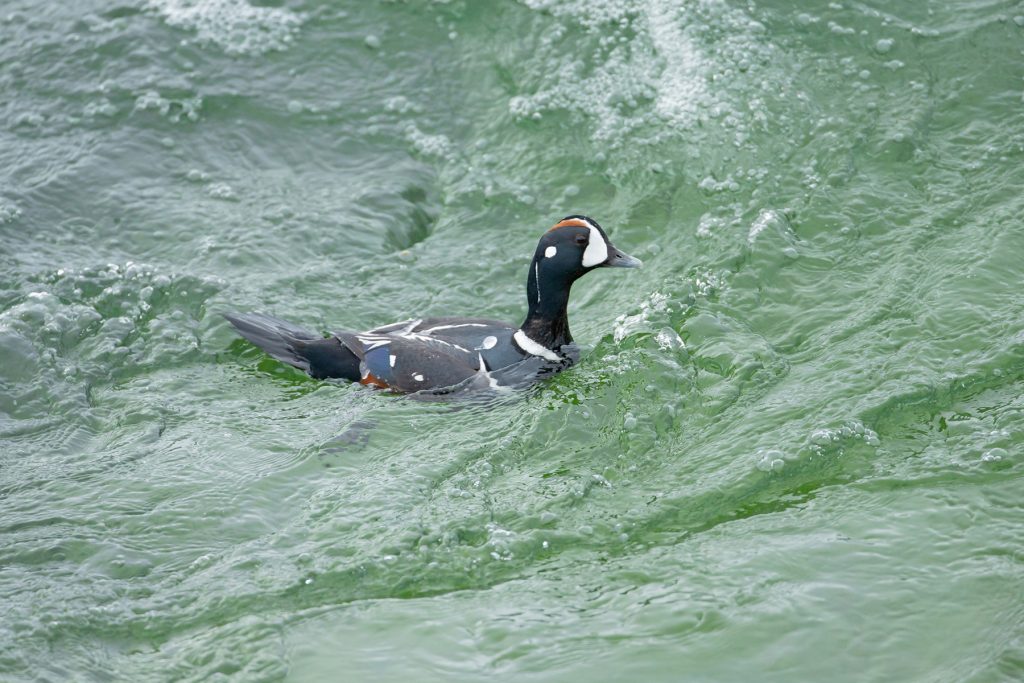
Harlequin is probably Iceland’s most iconic bird, there are few better locations to see them in the world than the rushing mountain rivers of northeast Iceland (image by Mike Watson)
Our two nights stay on lovely Flatey (‘Flat Island’) in Breiðafjörður, extended this time by one night owing to the seaman’s national holiday, was voted the highlight of the whole tour. It really is a gem of a location and was full of birds again. Diversity is low but there is a profusion of breeding shorebirds and seabirds, many of which are tame and photogenic. The grand prize, Red Phalarope, breeding at the southernmost limit of its range, put in a couple of appearances in the kelp, but its commoner, Red-necked cousins really stole the show. They were in every mire, even the tiniest ones, on every pond, along the seaweed covered shore and even along the paths, as they attended their fight club, the females squabbling over the males! Other species worthy of a mention are the angry birds – Arctic Terns, which have several colonies of Flatey, as well as eider, teal, redshank, snipe, turnstone, ringed plover, Black-tailed Godwit, Black Guillemot, fulmar, and Redwing. Snow Buntings were unusually abundant this year, singing from just about every building and even puffins are returning to breed on Flatey, affording good opportunities for those braving the weather, at least in flight. The hotel is under new management and was happily just as lovely as ever and the food was out of this world again!
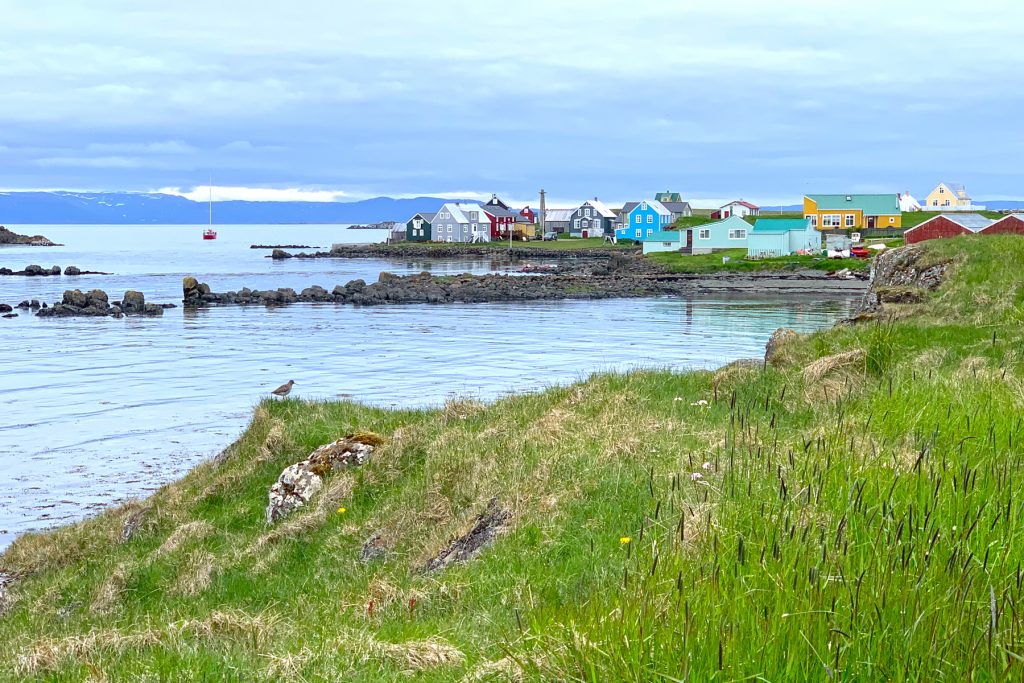
Idyllic Flatey is a perfect place to hideaway! If I disappear start looking there (image by Mike Watson)
The Snaefellsnes Peninsula was below par this time owing to heavy rain, but we squeezed in a nice visit to the basalt cliff seabird colonies at its western tip, between the downpours and we also made the effort to be at the iconic landscape location of Kirkjufell for what passes for sunset at this time of year in Iceland.
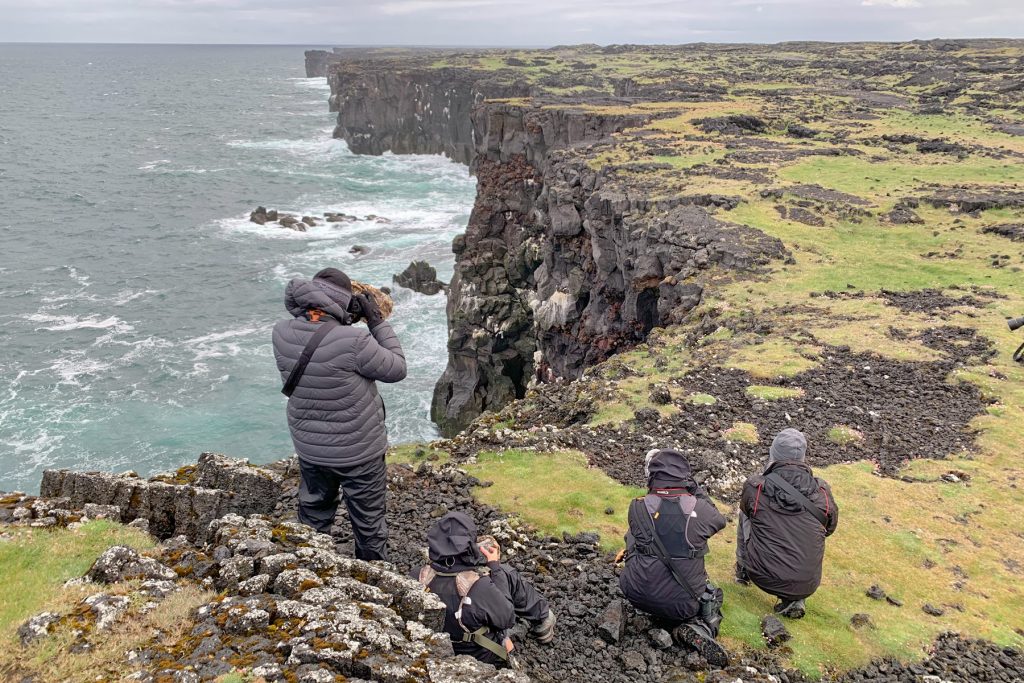
Basalt seabird cliffs at Svötuloft on the Snaefellsnes Peninsula (image by Mike Watson)
Whale watching in Skjálfandi Bay out of Húsavík never seems to fail and we enjoyed repeated close encounters with Humpback Whales against a snowy mountain backdrop – fabulous stuff as ever. Lake Myvatn had its moments too and between the swarms of chironomid flies, which seemed worse than usual this year, was some good Harlequin and Long-tailed duck action. Happily it only takes some wind to pick up and the flies soon disappear back from whence they came, so we did get a few fly-free frames. We had to look elsewhere for Slavonian Grebe and Common Loon opportunities this time as well as catching up with Icelandic favourites like golden plover and sea level ptarmigan (which was apparently at an all-time low last year).
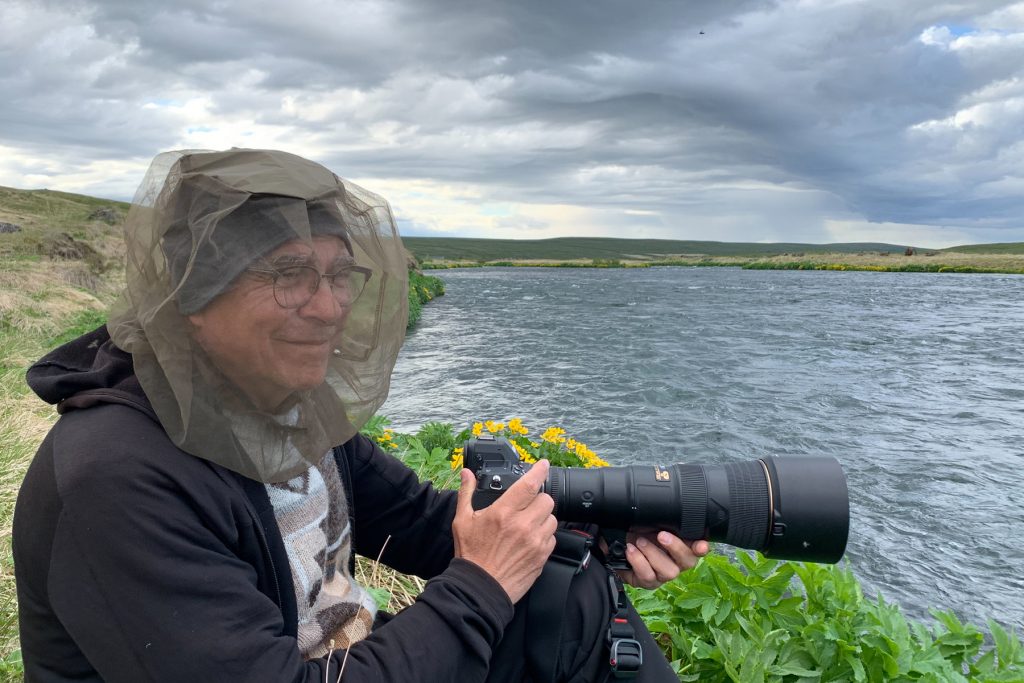
Well it is not called ‘Lake of the Flies’ for no reason, Frédéric near Myvatn (image by Mike Watson)
We enjoyed some wonderful waterfalls too. Iceland must be the best country in the world for them? These included Goðafoss and Dettifoss in the ‘Diamond Triangle’ of the northeast and Gullfoss in the ‘Golden Triangle’. We also visited some great volcanic landscape features from the mid-Atlantic rift (both in the north at Ásbyrgi and Þingvellir in the south), to the smoking fumaroles and boiling mud pools of Námafjall, the petrified lava field of Dimmuborgir and of course the mighty geyser Strokkur.
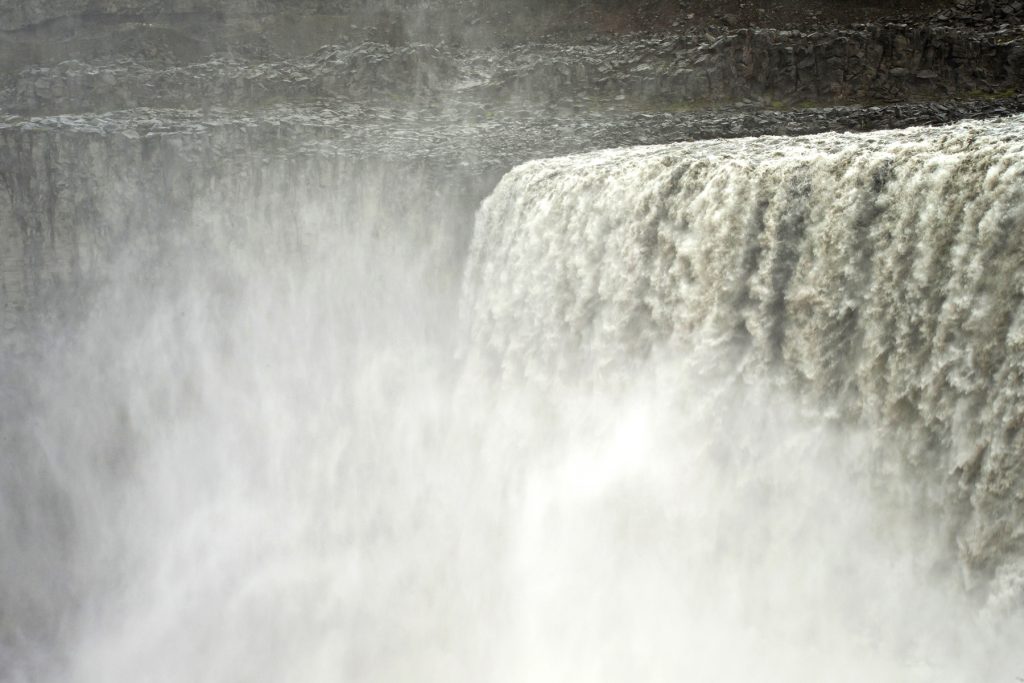
Mighty Dettifoss in cold blue light (image by Mike Watson)
Away from the hustle and bustle of the incredibly busy Keflavik Airport, we started our long journey to our accommodation near the tiny port of Stykkisholmur in Breiðafjörður at last. The overwhelming first impression of the Icelandic landscape on the Reykjanes Peninsula at this time of year is of a rugged tree-less countryside, covered by ancient lichen-clad lava flows with gaudy patches of blue Nootka Lupins. A little further north, towards the capital Reykjavik the lava flows give way to birch and willow trees on the outskirts of the city. The soft southwest was the first part of Iceland to be permanently settled, by the Vikings in AD871 (+/- 2 as the exact date is uncertain). The slightly milder climate here allowed trees and crops to grow and within a hundred years or so all the original woodland cover around Reykjavik had been cleared either for fuel or use as agricultural land. Driving north away from the capital, the roadworks for the rather unwelcome dualling of the ring road quickly petered out and the landscape gradually became much wilder. On a sunny afternoon we drove northwest, green pastures and marshes flew by with shaggy-maned Icelandic ponies here and there, overlooked by towering escarpments. The snow-capped peaks of the Snaefellsnses Peninsula stretched out to the west and the vast lava field north of Selvallafoss before us as we descended towards Stykkisholmur.
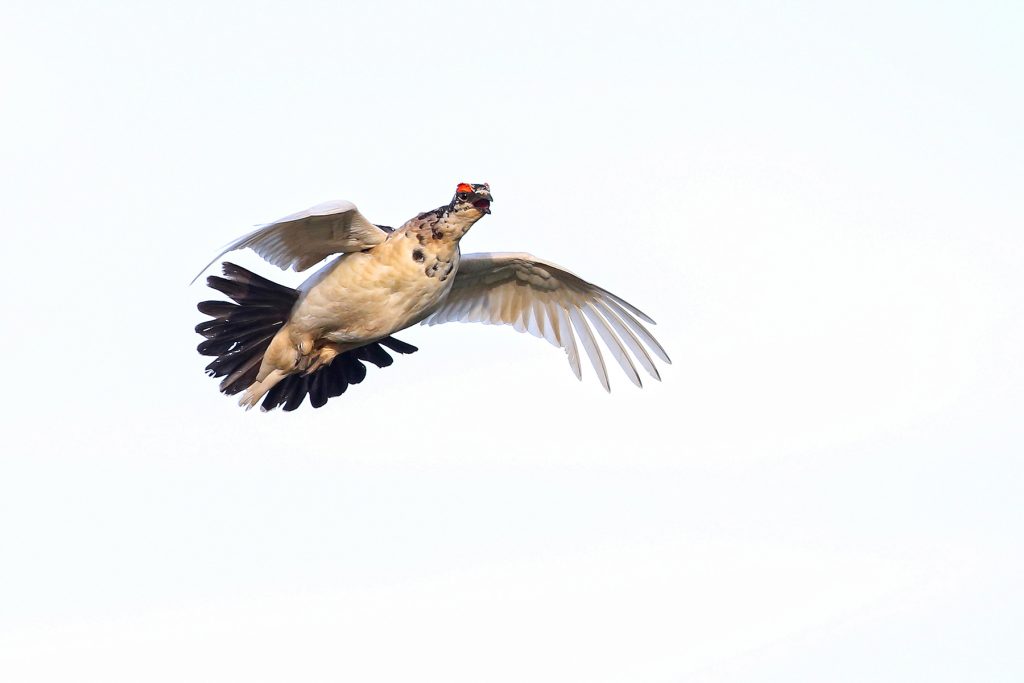
Rock Ptarmigans make noisy display flights (image by Mike Watson)
The weather for our return to this area after our short stay on Flatey looked very grim so, after checking in at a lovely little wooden lodge, we made an evening excursion to Grundarfjordur and Kirkjufell in particular. This is one of Iceland’s most iconic landscape photo locations and combines a cascading waterfall with a picturesque peak and rushing stream. It is also famous as a filming location in Game of Thrones. It appeared twice, in season 7, episode 6 when the heroes go to north of the wall, described as the ‘Arrowhead Mountain’. It had obviously shifted somewhat as it also appeared in season 6 episode 5, with Kirkjufellsfoss in view, when the children of the forest created the Night King. This was the first of five GOT filming locations that now happen to be in our path! It was a cloudy evening, and it was getting rather late, but we hoped the sun would dip below the blanket of cloud and illuminate the mountain sometime after 11pm. Low cloud drifted past and blocked successive attempts by the sun to break through, until eventually it did find a gap and lit up the lower slopes of the mountain in spectacular style, albeit only for a few minutes. As we returned to our rooms just after midnight, a chorus of redwings was singing from the low stands of willows in the valley below the lodge and a male ptarmigan stood watch from a small outcrop by the car park. It was wonderful to be back in Iceland. It was time to draw the curtains (although it was still broad daylight outside) and get some sleep.
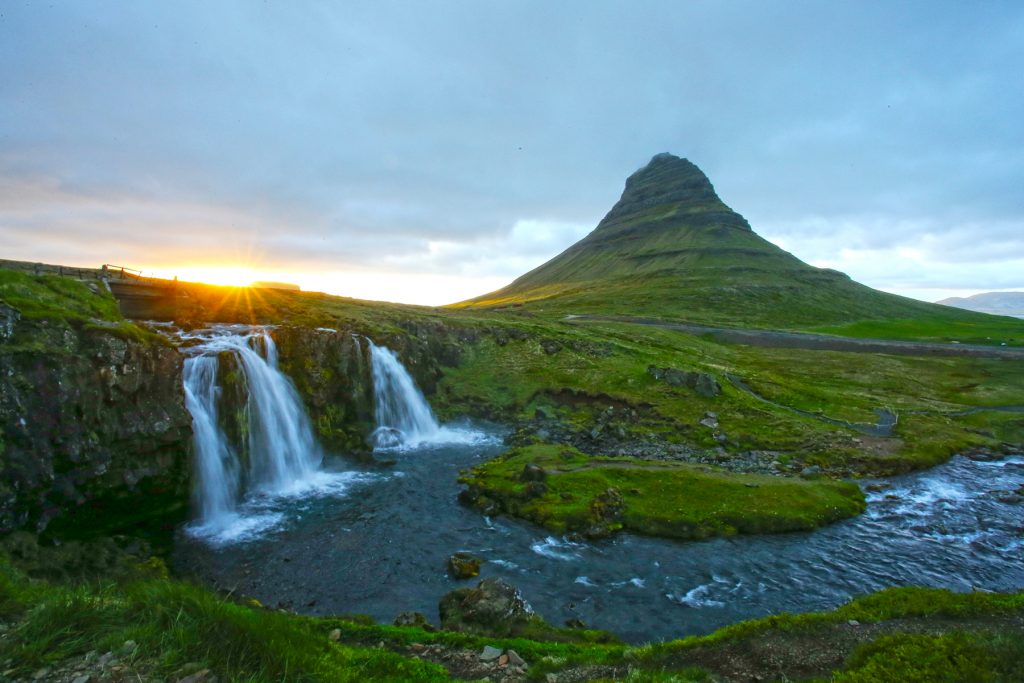
(Almost) midnight sunset at one of Iceland’s iconic landscape locations, Kirkjufell (image by Mike Watson)
We boarded the Ferry Baldur (‘Baldy’) next morning, and before long we passed by numerous small skerries in Breiðafjörður dotted with kittiwakes, fulmars, eiders, shags, puffins, and Black Guillemots. Barely off the quay on Flatey, the first Red-necked Phalaropes greeted us. Again, they were everywhere all over the island, in every tiny little mire and ditch and were ultra-tame as usual. Flatey is only two kilometres long and one at its widest and in the summer months it is a retreat of artists, writers, and wealthy bohemians as well as a few original families. In fact, money cannot buy you a house on the island, you can only acquire one by through inheritance or marrying into an island family and even then, many homes are owned by several generations of extended families and only have a limited number of weeks per year they can stay on the island. Its small church was built in 1926 and has an incredible mural painted on the ceiling featuring island life. Flatey has a winter population of only five people and is also the setting for Viktor Arnar Ingolfsson’s 2012 acclaimed novel ‘The Flatey Enigma’, which refers to the Flatey Book, an important medieval manuscript written between 1387 and 1394 by the monks who lived at the monastery. Then, once again, we began our search for our own ‘Flatey Enigma’, Red Phalarope. With no sign at the usual regular spots for it by lunchtime we headed to the hotel to check in and have lunch. The afternoon session immediately kicked off with a lovely Red Phalarope feeding in the kelp along the shore. It was a female in breeding plumage, not quite pristine, but it was very nice, nevertheless. It did not stay long, before flying off into the restricted zone/nature reserve of the northern half of the island. Happily, it returned soon afterwards for everyone to catch up with it, after clambering over seaweed-covered rocks to get closer to this little polar-breeding shorebird. It was completely unconcerned at our presence, but again it did not remain with us for long and was soon off on its way somewhere else. We saw it again the following day, but only once in flight and then on the third day we didn’t see it at all.
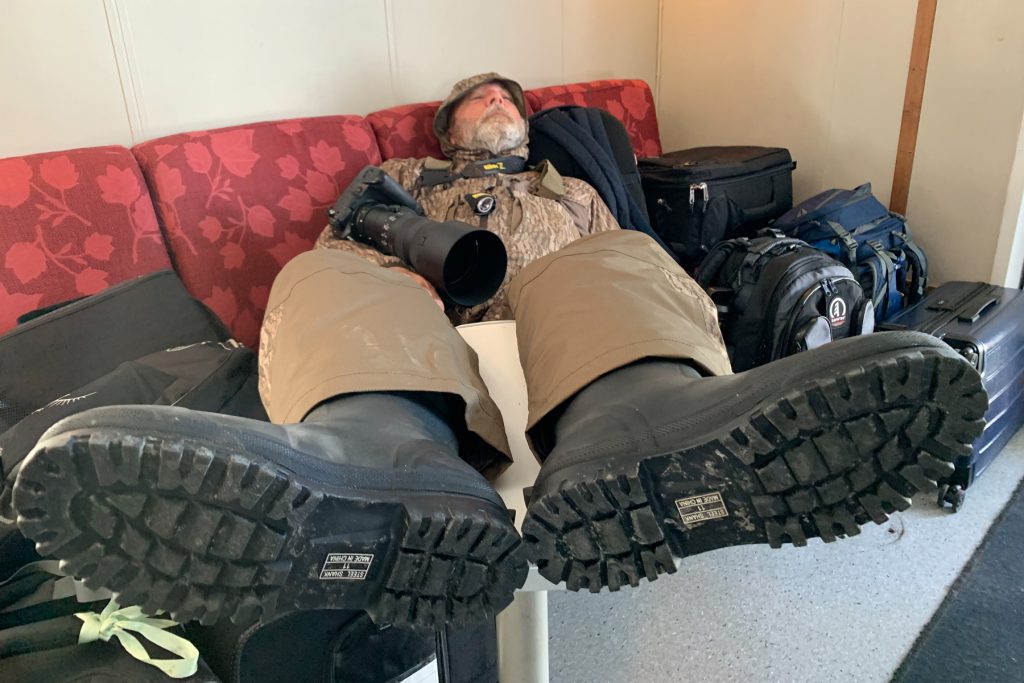
There is plenty to do in the midnight sun in Iceland, you may need to take a nap – Wilo on Ferry Baldur (image by Mike Watson)
Red-necked Phalaropes were very obliging and afforded at least one million photo opportunities. They could be found feeding along the shore in bad weather or picking tiny insects from dandelion flowers along the paths when the sun came out. It seemed that every tiny mire or ditch had one and we could even see them from the windows of the Hótel Flatey, only a few metres from the sea. They would even fly between the houses in the village and the hotel itself. Roles are reversed in phalaropes, with the males incubating the eggs and tending the young, long after the females have departed, maybe to lay eggs in another nest somewhere? We all took thousands of photos on Flatey and it was easily the single most productive place that we visited. However, this time there was a little less peace and quiet in the evenings owing to several house parties taking place. Unfortunately, our last day was almost totally lost to rain. Before it set in, we had a good flight shot session with the puffins but soon enough there were far too many raindrops in the air and too little light for anything. Of course, the birds do not like heavy rain either and most of them weren’t around to be photographed anyway. We spent some time hanging out in the hotel waiting for the weather to clear but it did not, in fact it got worse. We got some more extra time on Flatey thanks to the ferry running late all day. Sadly, all too soon it was time to catch the early afternoon ferry to the mainland and start the next leg of our journey. A trip to the phalarope island of Flatey is a must for anyone with an interest in wildlife visiting Iceland and we were very happy to have been able to stay there, photographing the tame birds, hanging out in the hotel, and watching the world go by… and by the way, did I mention the delicious food? We will certainly be back again!
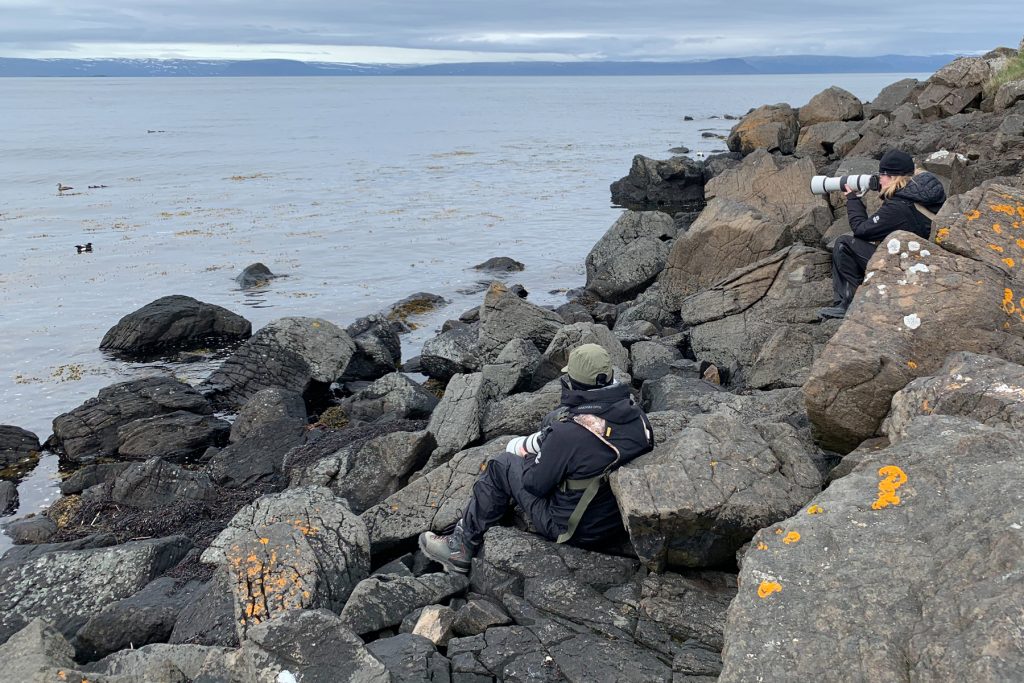
Photographing seabirds on Flatey (image by Mike Watson)
Off the ferry at last we made our way west along the Snæfellsnes Peninsula to the tiny fishing village of Grundafjordur. The Snæfellsnes Peninsula is described as ‘Iceland in miniature’. It has a bit of everything: menacing volcano cones; reindeer moss-covered lava fields; snow-capped mountains; impressive basalt sea cliffs; dramatically styled modernist churches; brightly painted buildings and the ubiquitous blue swathes of lupins. Snæfellsnes was silent, grey and wet and when we finally got to our hotel at the end of the Snaefellsnses Peninsula it was not far off midnight. It was lovely to see that the same guy who had been just starting out prior to the pandemic was still working here post-lockdowns, with a beaming smile despite the outrageously late hour. The rain had eased off a little, so we went cruising for Arctic Foxes. Sadly, almost as soon as we entered the National Park the heavens opened again and rained stair-rods on us. We saw a few uncooperative ptarmigans on the lava field but that was about it.
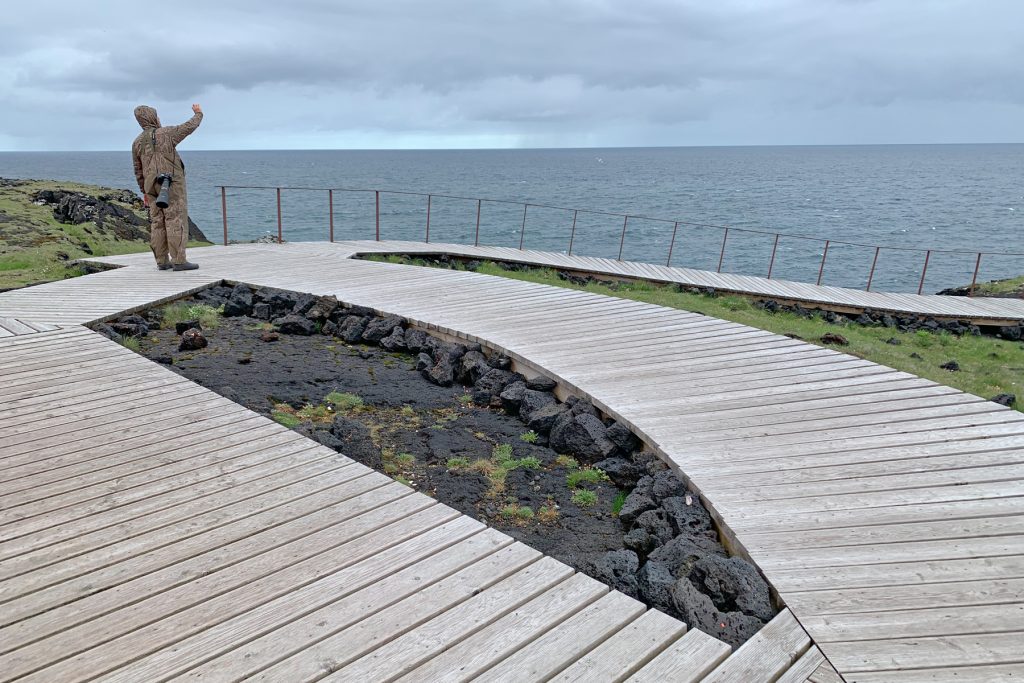
More no-expense-spared tourist facilities at Svötuloft (image by Mike Watson)
We retraced our steps next morning to the impressive bright orange Svötuloft Lighthouse. A well-built viewpoint complete with safety railings etc overlooks some seabird cliff nesting ledges and a very convenient row at the top of the cliff contained Razorbill, Common Murre (or Guillemot) and the highly sought-after Thick-billed Murre (or Brünnich’s Guillemot). The latter high arctic breeders are at the southernmost limit of their range in Iceland but are still easy to find at Svötuloft. A couple of pairs has nested on the same ledges below the viewpoint for at least the last ten years I have been going there. Inland from the basalt cliffs lie the immense lava fields emanating from snow-capped Snæfellsjökull (1446m), the summit of which was lost somewhere in the low cloud today. A lovely carpet of Mountain Avens (Dryas octopetala) stretched across the lava field here. Snæfellsjökull is probably best known as the setting for French author Jules Verne’s ‘Journey to the Centre of the Earth’ – “Whoever de- scends into the crater of Sneffels Yocul can reach the center of the earth”. Fancy living on a volcano, remembering that its 1100 known of years of dormancy is only the blink of an eye in geological time? Research has shown that the Snæfellsjökull system has erupted at least 25 times in the last 10,000 years. I wonder when the next one will be?
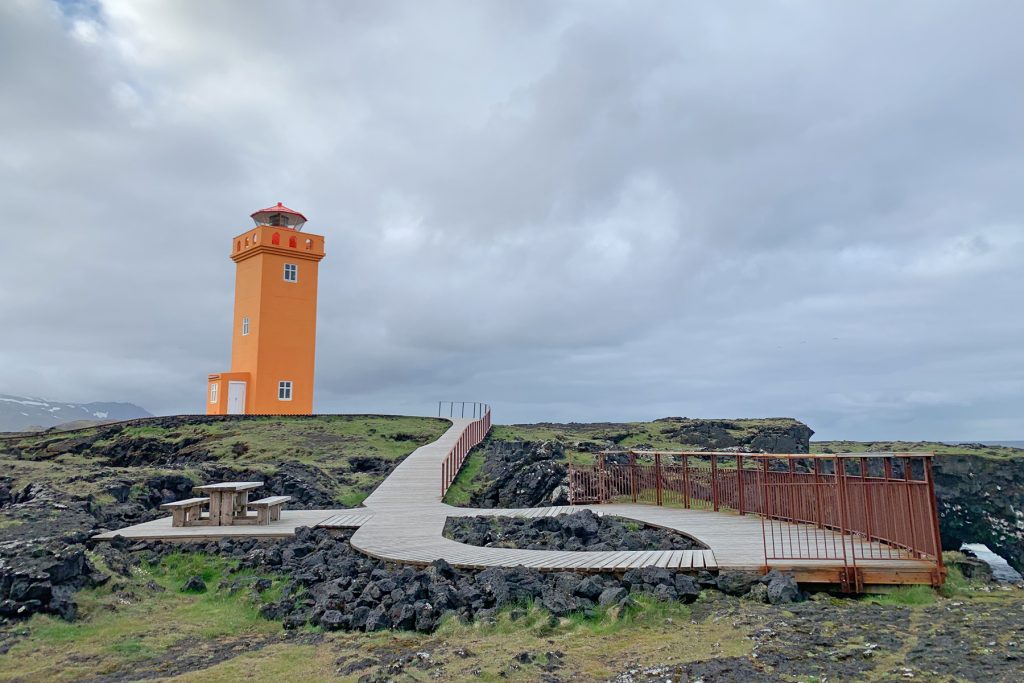
The bright orange Svötuloft Lighthouse (image by Mike Watson)
Iceland continues to experience much seismic activity and some of its volcanoes do not give much warning of an eruption. For instance, Hekla, the ‘Witch Volcano’ in Southern Iceland was considered to be the gates of hell until the 1800s! It ought to be feared as it is aseismic and there is sometimes a warning of only an hour or less of an eruption, eruptions can last for years and there have been 20-30 of them since the first documented in AD1104. Traces of its eruptions have been detected in Scottish bogs, while in Ireland up to a decade of negligible growth can be seen in tree rings, all making the 2010 eruption of the well-known Eyafjallajökull seem rather insignificant. Another reason to fear Hekla is that the longer a volcano remains dormant then the more violent the eventual eruption is expected to be. We will all be in big trouble if it blows in our lifetime. The lava fields are generally inhospitable and hold few species, but European Golden Plover is one of the few shorebirds that appears to like them. A couple of wheatears were seen down at Hellnar Lighthouse but otherwise little else apart from some nice, rounded basalt pebbles and it was time to head northeast. We had a long journey ahead of us to get to Húsavík. This time we avoided the long gravel short-cut and stayed on the tarmac stopped for lunch at one of the ubiquitous N1 petrol stations, doubling as a tourist fleecing point, selling all kinds of souvenirs and clothing. The long journey eastwards was livened up our first Slavonian Grebes and Pink-footed Geese, including a roadside colony, which has become established where extensive gravel bunds have been raised to protect the road from erosion.
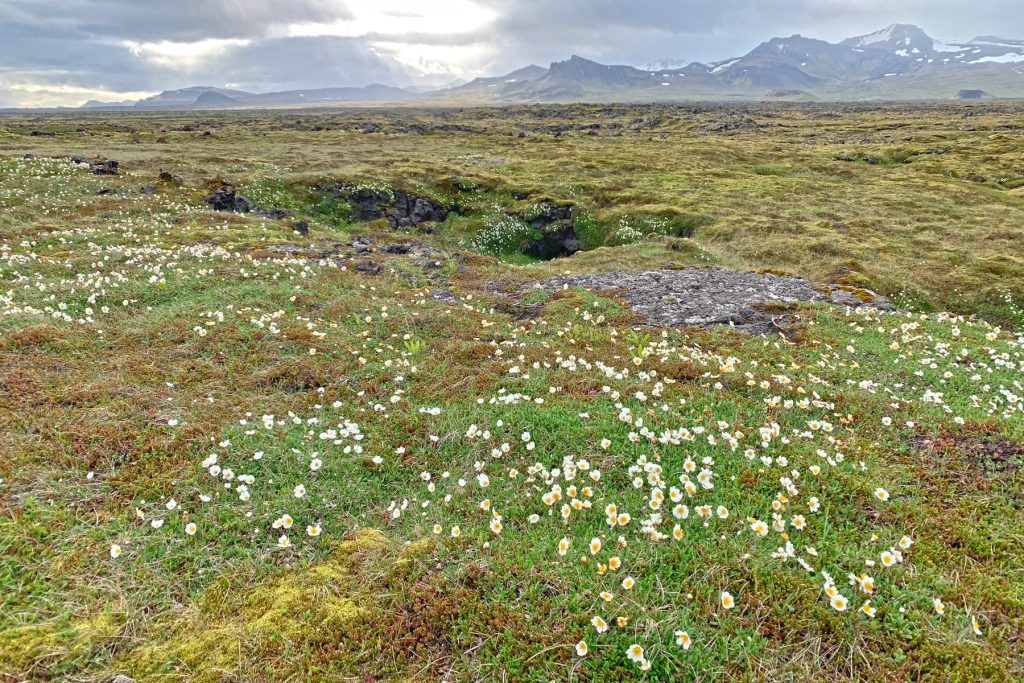
Pretty Mountains Avens carpets the older lava fields at Snaefellsnes National Park (image by Mike Watson)
Late in the day we eventually reached Húsavík (‘Bay of Houses’), population 2,237, which was the first place in Iceland to be settled by a Norse man, in AD870, when Viking Garðarr Svavarsson spent a winter here. According to history, he owned land in Zealand (Denmark) and was married to a woman from the Hebrides. During a voyage to those isles to claim his inheritance from his father-in-law, he sailed into a storm, which pushed his ship far to the north until he reached the eastern coast of Iceland. Húsavík is an outlet for silica mined at Lake Myvatn and there is now a large silica processing plant just to the north of the town. It is thankfully screened by large embankments. However, its other sources of income are fishing, and tourism (particularly whale-watching) and it is the gateway to the new ‘Diamond Triangle’ of tourist attractions. We took two excellent whale watching boat trips on this itinerary, on consecutive days this time. We received narratives from the well-trained caller and even hot chocolate and cinnamon buns for the return dash to port. Sea conditions were calm on both occasions, and we had numerous sightings of Humpback Whales, seven or eight on the first trip and at least two on the second, and we enjoyed some great surface action with these incredible creatures. The whale watching boats co-operate with each other, so sightings are more or less guaranteed. I think the success rate is more than 95% for instance for a whale sighting of some sort and the later boats are particularly successful simply ‘taking the baton’ from the earlier ones. The waters of the bay are not so deep, and the food is near the surface, so the whales do not have to dive for long, surfacing every few minutes. Therefore, we got a lot of views, albeit mostly just a blow from the nostrils, some back and dorsal fin and sometimes the tail as well, although deep dives kicking up a vertical tail view were few. Some were very close to the boat and the sound of the blow was often the first sign of a whale surfacing nearby. Strangely there were no other cetaceans seen on our trips (the boats will always go for a Blue Whale if one has been spotted) but not even a Minke or White-sided Dolphin this time. Birds on the boat trips included Great and Arctic Skuas, Atlantic Puffin, Common Murre and Black Guillemot as well as many Northern Fulmars, Arctic Terns, and Black-legged Kittiwakes. However, bird photographic opportunities were rather poor on the small boat.
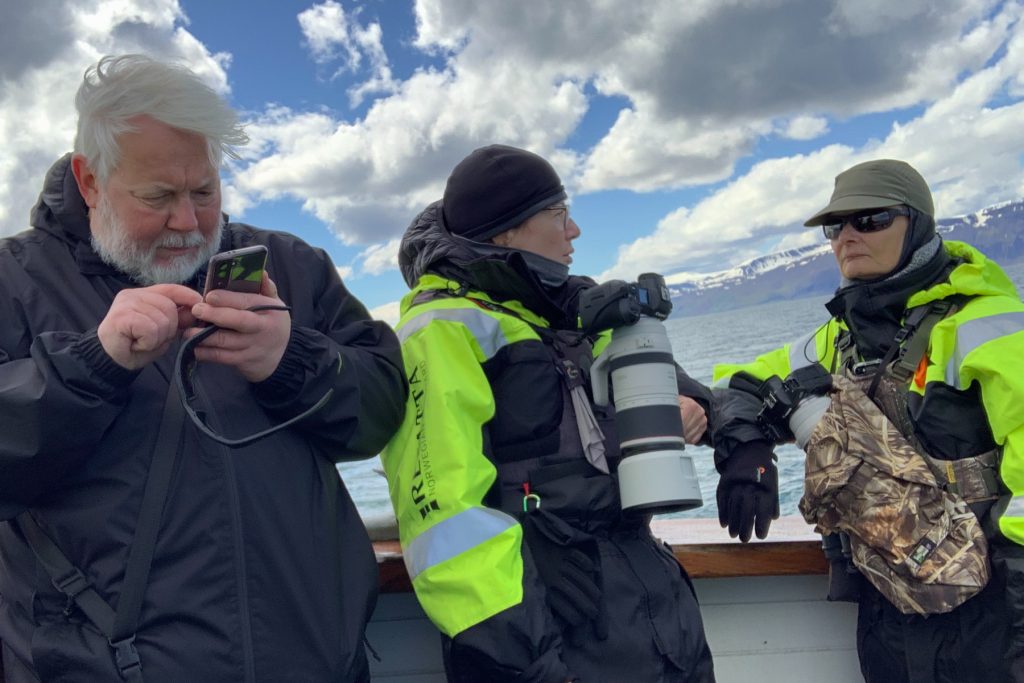
More happy Wild Images whale watchers at Husavík (image by Mike Watson)
After the whale trips we stocked up with pastries and headed off to the Lake Myvatn area. This is one of my favourite places in the world, a landscape of rushing torrents, lined with marigolds, cascading through lush green marshes and heathland dotted with lovely wildflowers. Dark volcano cones loom and snow-covered mountains stretch into the distance, often under a suffocating blanket of leaden skies. This is Northeast Iceland, the domain of the Harlequin Duck. Just as attractive as the landscape, which it inhabits, this hardy little duck could well be the prettiest of all, depending on your favourite colour. Blue maybe? Finished with striking ivory white spots and stripes, as well as deep chestnut flanks and head markings drake Harlequins are masterpieces of natural design. We had hoped for some interesting light at the time of our visit to the Laxá, and although we got some, unfortunately we got the ‘Lord of the Flies’ experience this time and they were rather prolific, appearing as a mist in many of our Laxá photos. There were simply too many to clone out. When the wind picked up, they would retreat into the vegetation but within minutes of it dropping they were out in force again and annoying us. Thankfully, they are non-biting chironomids, but they are so numerous at times as to be a menace. It is difficult to get the timing right for a visit to the Laxá as their numbers depend on how early (or late) the spring is weatherwise. Ultimately, we managed some fly-free images, but it was hard work. Unless of course you simply give in and show the image including flies. After all that captures the atmosphere of this special place, the air is literally alive with bird food.
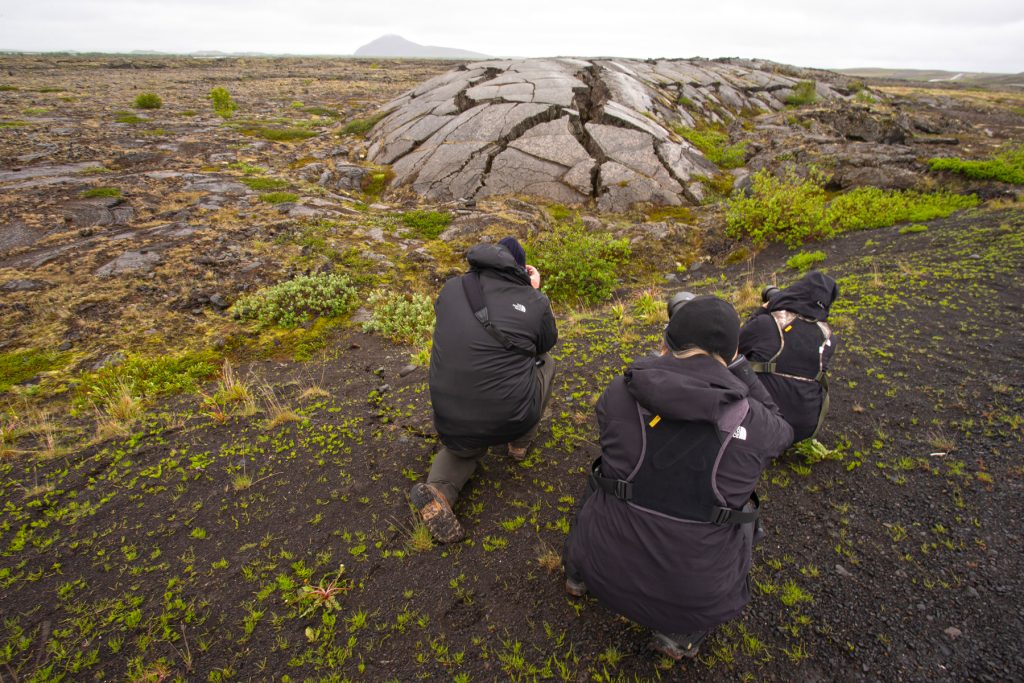
Volcanic landscape photography taking place at Lake Myvatn (image by Mike Watson)
It is always hard work to keep up on the Laxá but once you’ve set a shutter speed sufficient to freeze the action, all you need to do is to concentrate on focusing on the birds, which is another challenge, as they disappear momentarily behind standing waves in the white-water of the river. Thankfully we were still in time to catch some drake Harlequins before they disappear downstream towards the coast. A week later and they would almost all be gone. Also, along the gorgeous Laxá (‘Salmon River’) were Barrow’s Goldeneyes, Long-tailed Ducks, Eurasian Whimbrels, Black-tailed Godwits and Parasitic Jaegers (Arctic Skuas).
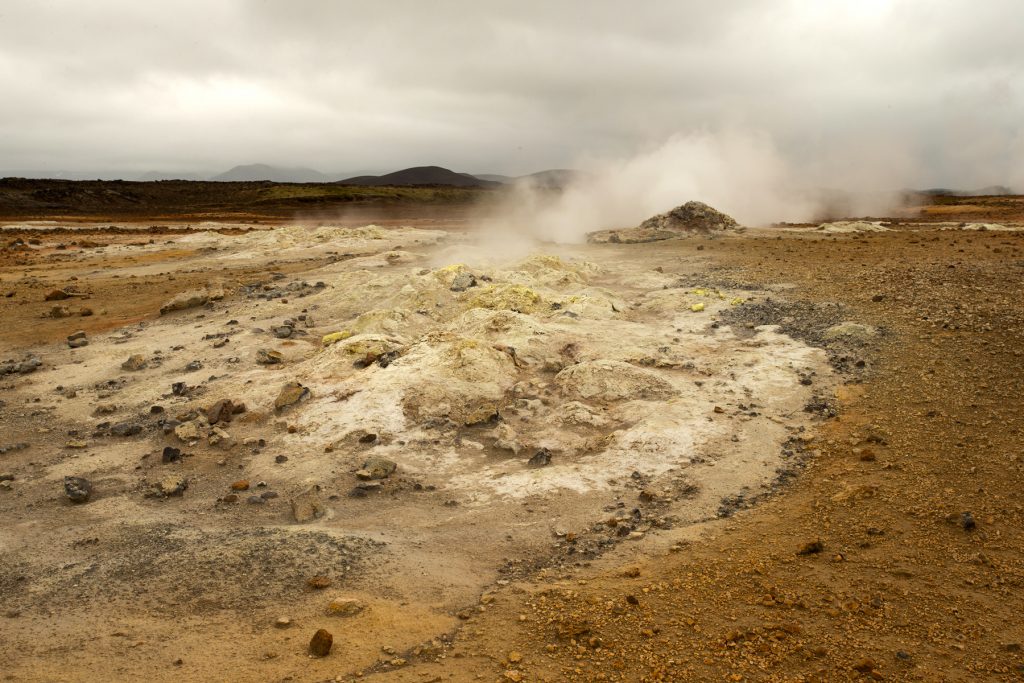
Namafjall in northeast Iceland (image by Mike Watson)
When I was a kid, I borrowed John Gooders’s 1970 book ‘Where to watch birds in Britain and Europe’ from the library numerous times. It has a chapter about Iceland, and I remember reading about Lake Myvatn. He wrote “It is, of course unthinkable that anyone should go to Iceland for birds without visiting Myvatn”. Lake Myvatn is full of waterfowl, a magical area of crater lakes and marshes surrounded by volcano cones, rootless craters, historic lava flows and hot springs. Myvatn famously means ‘Fly Water’. Amongst the throng of mostly Eurasian Wigeon and Gadwall and Tufted Ducks were Whooper Swans, Northern Pintail, Greater Scaup, Common Scoter, Long-tailed Duck and Red-breasted Merganser. Also, on Myvatn’s main lake and its many smaller satellite lakes were Red-necked Phalaropes and in the highlands of the northeast we saw several flocks of Pink-footed Geese, they apparently go to Greenland to moult! During our time in the Myvatn area
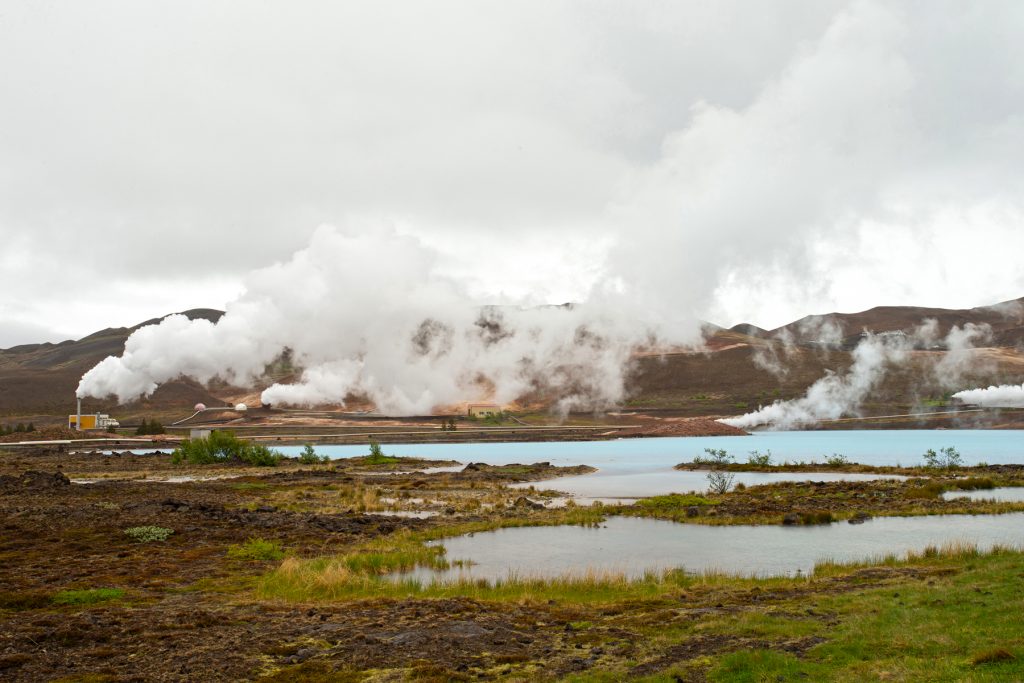
Geothermal energy plant at Lake Myvatn – Icelanders don’t rely as much on gas and electricity for power as some! (image by Mike Watson)
We made the most of pre-breakfast outings in the northeast, concentrating on bird photography and sessions resulted in some nice encounters with breeding Slavonian Grebes and Common Loons as well as some commoner species like Rock Ptarmigan, golden plover, whimbrel, Black-tailed Godwit and Whooper Swan. We also had a look at Iceland’s only (ever) Black-throated (or Arctic) Loon. It is thought to have been responsible for all of Iceland’s records and has spent the last four summers on Vestmannsvatn. It was nice to hear it wailing (in vain) in the hope of attracting a mate even if it did keep its distance.
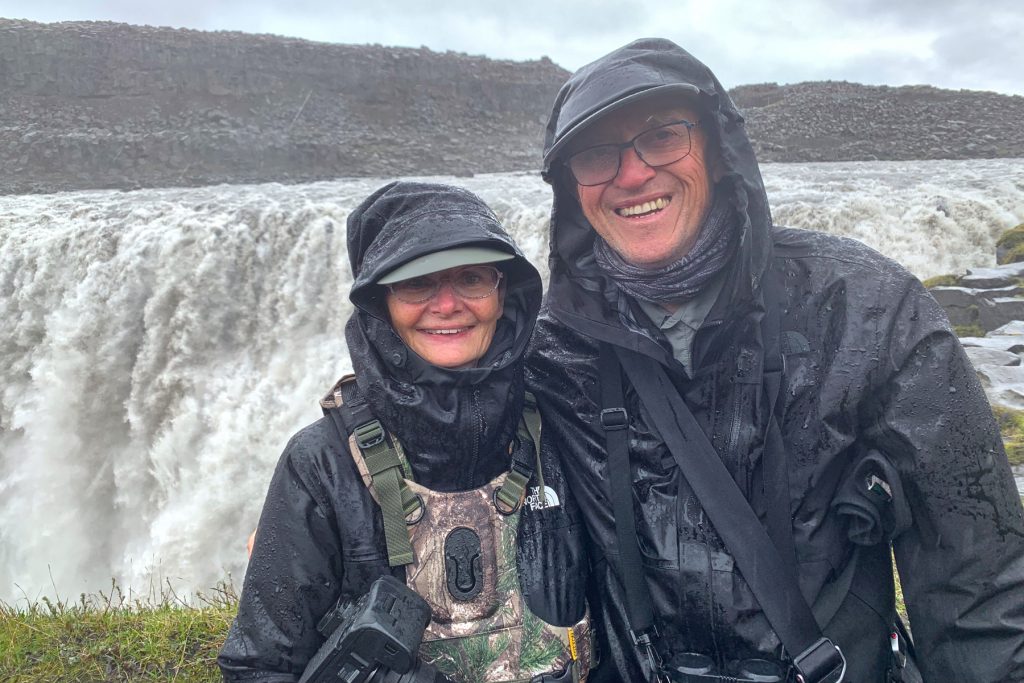
No-one minded the rain! Johanne and Michel at Dettifoss (image by Mike Watson)
One day we visited Goðafoss (‘God Falls’), which were so named when a local chieftain converted to Christianity and threw all the icons of his Norse gods over the falls. This is particularly lovely waterfall and very photogenic. At the head of the valley a drake Smew had taken up summer residence on a remote lake, but unfortunately it too remained out of acceptable DSLR range. As our time in the northeast drew to a close, the rain set in, and we turned our attention to geology. We had a quick look at the mid-Atlantic ridge, which is a rift in northern Iceland. Iceland is growing by c2cm per year right here, with the Eurasian and North American plates being torn apart. Here Europe stands taller than America with a rift between them. We called in at Dettifoss (‘Collapsing Waterfall’), Europe’s most powerful waterfall by volume with 193 cubic metres per second going over the 100m wide/45m high drop into the narrow canyon of the Jökulsá á Fjöllum river, which is a glacial melt river of the Vatnajökull (‘Lakes Glacier’). It was a sound as well as a sight experience as the huge volume of brownish glacial water thundered over the falls. The waterfall appeared in the 2012 sci-fi film ‘Prometheus’ as an alien planet landscape. This time we viewed it from the west, accessed by a very nice tarmac road – in the rain. Some prefer this aspect anyway to the view from the more remote eastern side. On a rainy afternoon we called in for lunch at Dimmuborgir, a large and strangely formed lava field and yet another GOT filming location, which appeared in S3E1,2 & 5 as the Wildlings’ camp north of the wall. We also visited a lovely little birch wood with a carpet of Wood Crane’s-bill (Geranium sylvaticum) and Alpine Bartsia (Bartsia alpina) where we saw a couple of Icelandic Wrens, as well as Redwings and particularly obliging redpolls. This was in fact near another Game of Thrones filming location, the lava towers at Höfdi, which featured in S3E5 as where Mance Rayder (the ‘King beyond the Wall’) set up camp. We also visited some fascinating hot springs and boiling mud pools at Hverir at Námafjall, where the black mud of foul-smelling sulphurous hot springs bubbled away, and jets of steam were emitted from vents. Traces of beautiful, yellow sulphur could be seen everywhere on the ground. At 1km below the surface the temperature is 200 degrees Celsius. In Iceland sulphur was mined for gun powder in previous centuries. This location featured in GOT S3’s opening scenes where Sam is wandering through an impenetrable blizzard, the blizzard is in fact the thick mist emanating from the geothermal vents!
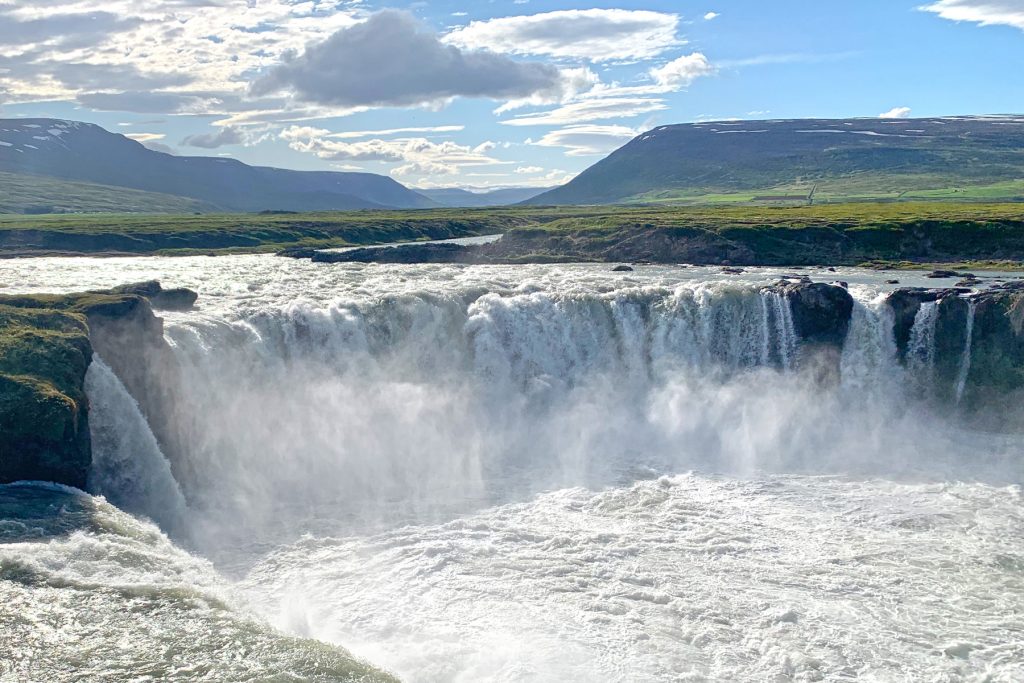
Godafoss is a perfectly formed horseshoe falls in northeast Iceland (image by Mike Watson)
The final leg of our journey was a very long driving day, the first couple of hours of which were spent in atrocious conditions with horizontal rain and very strong crosswinds. As we ventured south the weather improved and we passed Reykjavík again, which does not feel like a city at all, with a population of 122,000 (it is smaller than High Wycombe and would only just scrape into the top 60 largest towns and cities in the UK, ahead of Eastbourne but behind Accrington! The whole country’s population is only 357,000, significantly smaller even than Luxembourg, Malta or the Bahamas! We called in at Palli’s famous knifemaking workshop on the outskirts of the city by the entrance to the ‘Golden Circle’, where he makes traditional knives and other cutlery in a Nordic style with handles made from local materials.
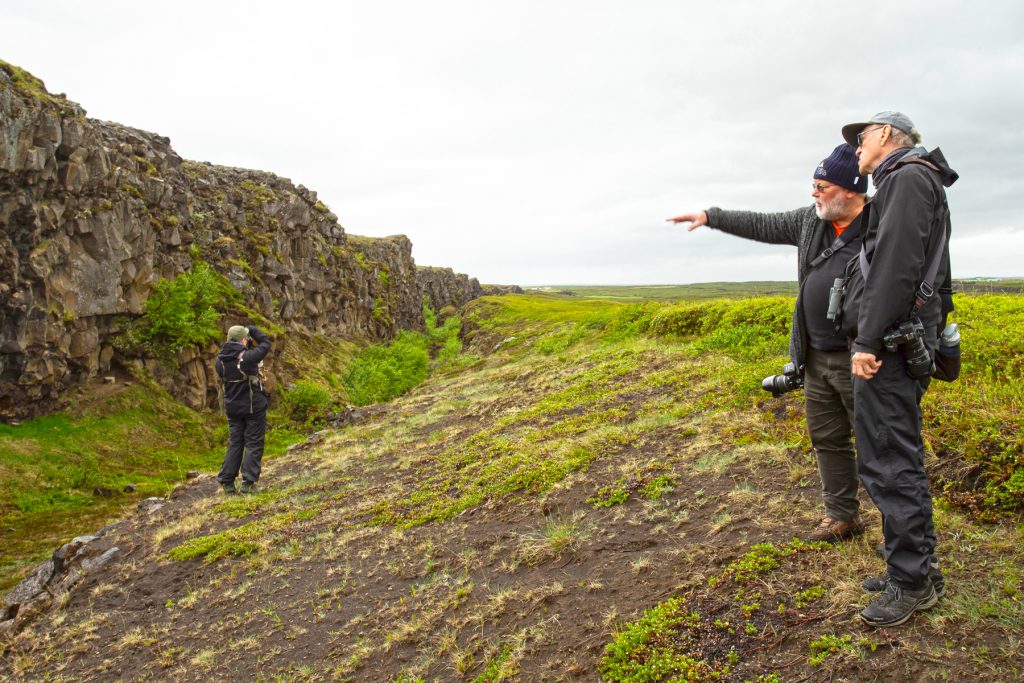
Our guest geologist Ian gives a free lesson at the mid-Atlantic Ridge at Asbjyergi in northeast Iceland (image by Mike Watson)
The final leg of the tour was simply some relaxing sightseeing, starting with the impressive Strokkur geysir at the small hamlet of Geysir – the origin of the word. This is the most active of Iceland’s geysers, erupting every few minutes and it even did a couple of double blows for us. The challenge is to capture a sequence including the surreal looking blue dome of water of the geyser, just before it bursts to send a steaming jet into the air. Next came the excellent Gullfoss (‘Golden Falls’), with its thundering staggered double step falls and deep canyon. We were lucky to see a nice rainbow that forms over the falls in mid-afternoon when it is sunny at this time of year. The programme for the final morning of the tour was simply another of the ‘Golden Circle’ tourist attractions, Þingvellir, the site of the original Iceland parliament. People from all over Iceland gathered here for two weeks every summer, to watch the parliamentary proceedings (especially before the law was written down) and to settle disputes. It was also a site of capital punishment until the 1600s where people were either drowned (women), beheaded (men), hanged or burned alive. It also sits on the mid-Atlantic Ridge by a beautiful lake. A truly amazing setting. However, it is now very much touristified, and is covered with boardwalks to prevent the zillions of tourists from damaging it. We spent some time photographing the small but perfectly formed waterfall here, Öxarárfoss. What to do with a waterfall? Wide angle, panorama, close up, motion blurred slow shutter speed, black-and-white, infra-red, normal video, time lapse video, slo-mo video? There are lots of options! All too soon though it was time to return to Keflavík International Airport, just over an hour away where our adventure ended.
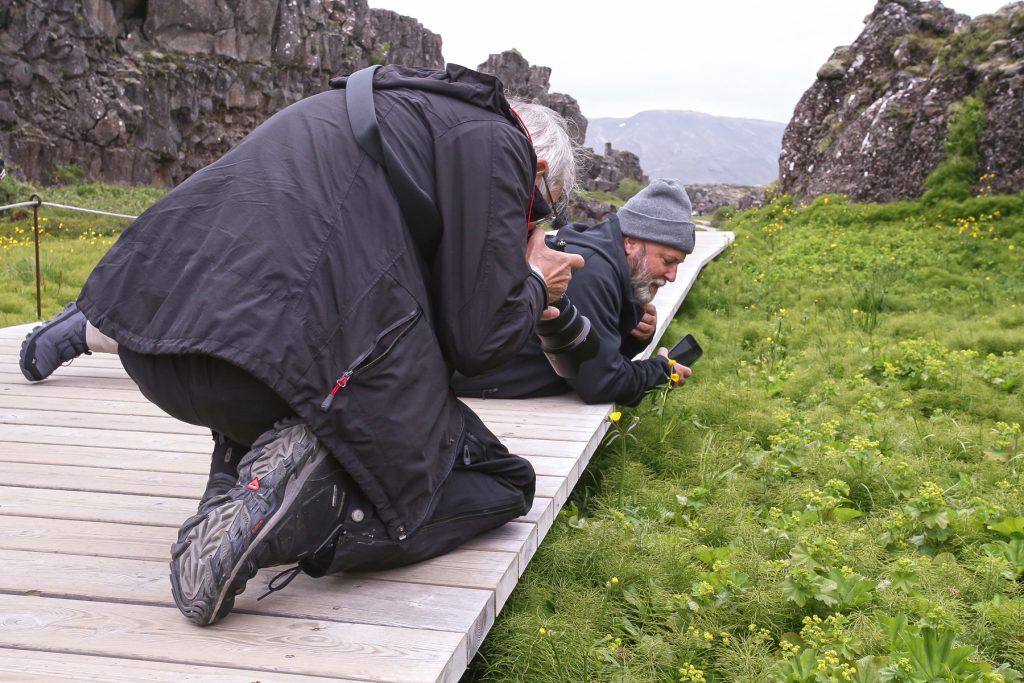
Macro magic happening at Þingvellir (image by Mike Watson)
As always, everywhere we went, we found the local people incredibly polite and friendly. This, combined with a good road network, spotlessly clean hotels, excellent food (especially soups and seafood) makes Iceland a very enjoyable, if rather expensive, country to travel in. After our 2500km road trip we felt like we had seen quite a lot of it. Finally, thanks to our very enthusiastic group of photographers who made this photo tour so much fun, we had a lot of laughs this time!


























































































